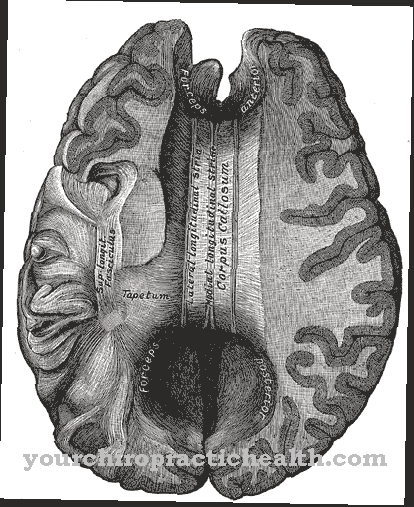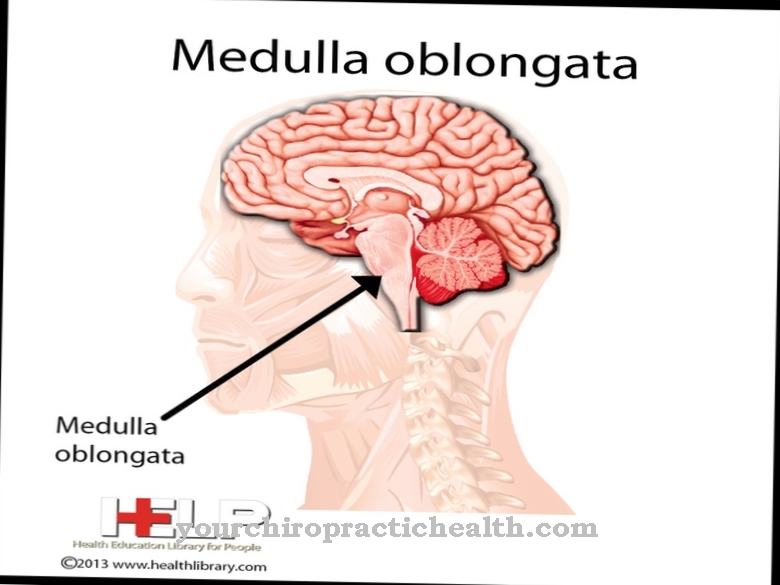Of the Rectus sinus is a blood conductor of the human brain. It runs in the back of the head. Venous blood flows in it.
What is the rectus sinus?
The human brain is supplied by various blood conductors. They consist of arteries, veins, and durae sinuses. Various messenger substances, cells or blood plasma are transported in them. They supply the different areas of the brain and activate them. At the same time, they also remove brain water.
They are all assigned to the central nervous system. Venous blood flows in the veins and sinus durae matris. There are different veins that run their paths on the superficial or in deeper tissue layers. The rectus sinus is one of the most important blood vessels of the durae matris sinus. It flows together with the transverse sinus and the sigmoid sinus along the occipital base of the skull. Other important blood conductors are the superior and inferior sagittal sinus and the cavernous sinus. Sinus thrombosis is one of the most important diseases. A clot forms in the bloodstream, which can cause blood congestion and ultimately life-threatening conditions.
Anatomy & structure
There are several deep veins in the human brain. They drain the blood in the diencephalon. They include the basal vein and the internal cerebral vein. With their branches they supply areas of the basal ganglia, the hypothalamus and the midbrain.
The basal vein and the internal cerebral vein on both sides of the brain eventually unite to form the great vena cerebri. This has a short dorsal course. It flows towards the back and opens into the rectus sinus. At the same time, the saittal inferior sinus ends in the rectus sinus. This previously runs along the lower edge of the falx cerebri. This is the cerebral sickle, which is surrounded by a hard membrane, the dura mater encephali.
The rectus sinus continues to the confluens sinuum in the back of the skull. There it flows together with the superior sagittal sinus. This runs along the upper edge of the falx cerebri. The transverse sinus is directed to the right and left of the confluens sinuum. It frames the posterior fossa.
Function & tasks
Together with other blood conductors, the rectus sinus supplies the brain areas of the occipital area. It drains the surrounding tissue and supplies other deeper veins. He is responsible for supplying large parts of the back of the head with venous blood. Essential substances and substances are transported with the blood. They include protein-containing blood plasma, hormones, cells or oxygen.
In a few seconds or minutes, these can get from one place to another through the various blood vessels and develop their effect there. Transmitters in particular are transported to their corresponding receptors via the bloodstream. This enables the individual functions of organs to be activated or also regulated. In addition, cerebrospinal fluid is removed via the rectus sinus. This forms in the various cerebral ventricles and the spaces between the brain. The cerebrospinal fluid is known as the cerebrospinal fluid and is eliminated through the bladder.
The rectus sinus takes over the function of temperature regulation in the brain. So that the brain areas can pursue their activity, they need optimal warmth. The temperature inside the human organism is approximately 37 degrees. The heat is retained in the body via the blood. If the temperature rises or falls sharply, the organism tries to compensate for this across the entire bloodstream. The venous blood in the rectus sinus is often used in medical interventions for control purposes for a blood sample. At the same time, it is used to supply drugs or various messenger substances that are intended to improve health. This is also done within one operation.
You can find your medication here
➔ Medicines against memory disorders and forgetfulnessDiseases
The blood conductors in the brain are well protected by the base of the skull. However, if there is damage to the vessel wall as a result of accidents, falls or surgery, blood escapes, which is difficult to stop.
The hemorrhage leads to brain swelling and tissue displacement. The pressure inside the brain increases. Headaches, deficits in affected areas, psychomotor slowdown or even impaired consciousness occur. In severe cases, there may also be a loss of consciousness. Blood congestion in the rectus sinus is particularly dangerous. It can be triggered by a blood clot and is known as sinus thrombosis. The congestion of the blood leads to the death of the brain cells.
Many patients suffer permanent damage such as paralysis or speech disorders. A stroke or stroke can result, in some cases fatal. If you have spontaneous feelings of tension in your head, you should therefore hurry. A doctor should be consulted immediately. Important messenger substances are transported to a place of action via the blood and also derived. If a tumor develops in the human organism, there is a risk that tumor cells could detach.
These are then transported to other parts of the human body via the various blood conductors. It is therefore possible that the rectus sinus becomes such a blood conductor and contributes to the fact that new metastases develop in an existing tumor disease. This would mean that cancer would spread further and, overall, minimize the chances of recovery. The spread of viral or bacterial diseases is also given. The viruses or bacteria reach other parts of the organism via the blood, where they can continue to multiply and worsen health.



























